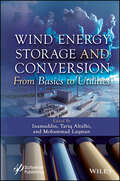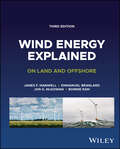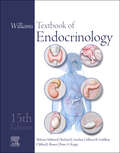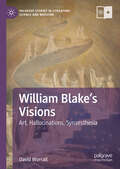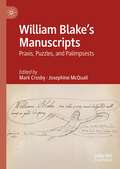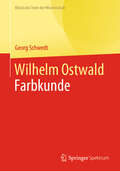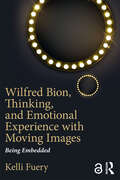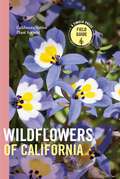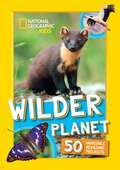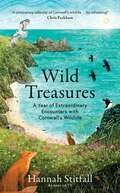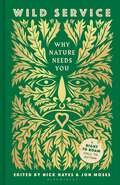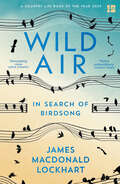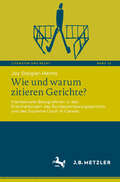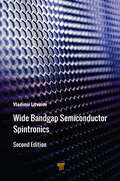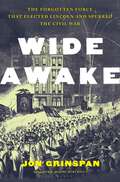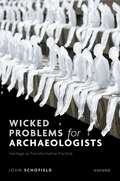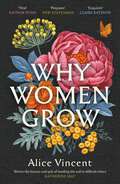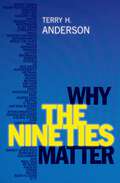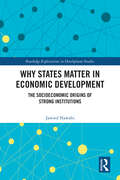- Table View
- List View
Wind Energy Storage and Conversion: From Basics to Utilities
by Inamuddin Tariq Altalhi Mohammad LuqmanBy going through this book, one can learn more about the usefulness of adopting renewable energies, particularly in light of the widespread use of wind-based devices. Here, we present an in-depth presentation of several developments in wind technological systems, focusing on applications and operational approaches. With the depletion of fossil fuel-based energy resources, the development of alternative sources of energy is becoming extremely crucial. Meanwhile, the planet is on the brink of an energy disaster due to the rapidly rising global need for energy. Additionally, the widespread usage of fossil fuel-based energy resources is aggravating global warming and harming the environment. However, there are reliable and eco-friendly substitutes to fossil fuels, for example wind and many other sustainable energies. Considering its low operational costs and easy accessibility, wind is among the most cost-effective and efficient renewable energies. With the increased use of wind energy, the need for storage has become critical. In addition to various storage procedures, fuel cells and batteries are two primary sources of compensation for RE systems. The wind technological system is on the cusp of development, but numerous improvements are required to make this technology overall cost-efficient. In this book, various energy storage and conversion methods for wind power applications are explored. Additionally, this work covers the costs associated with electrical output in wind-powered power plants as well as the financial and environmental plans that describe the installation of wind technology systems.
Wind Energy Explained: On Land and Offshore
by James F. Manwell Emmanuel Branlard Jon G. McGowan Bonnie RamWIND ENERGY EXPLAINED Authoritative and bestselling textbook detailing the many aspects of using wind as an energy source Wind Energy Explained provides complete and comprehensive coverage on the topic of wind energy, starting with general concepts like the history of and rationale for wind energy and continuing into specific technological components and applications along with the new recent developments in the field. Divided into 16 chapters, this edition includes up-to-date data, diagrams, and illustrations, boasting an impressive 35% new material including new sections on metocean design conditions, wind turbine design, wind power plants and the electrical system, fixed and floating offshore wind turbines, project development, permitting and environmental risks and benefits, turbine installation, operation and maintenance, and high penetration wind energy systems and power-to-X. Wind Energy Explained also includes information on: Modern wind turbines, covering the design and their many components such as the rotor, drive train, and generator Aerodynamics of wind energy, covering one-dimensional momentum theory, the Betz limit, and ideal horizontal axis wind turbine with wake rotation Environmental external design conditions, such as wind, waves, currents, tides, salinity, floating ice, and many more Commonly used materials and components, such as steel, composites, copper, and concrete, plus machinery elements, such as shafts, couplings, bearings, and gears Modern design methods, including probabilistic design Environmental effects and mitigation strategies for wind project siting and the role of public engagement in the development process This book offers a complete examination of one of the most promising sources of renewable energy and is a great introduction to this cross-disciplinary field for practicing engineers. It may also be used as a textbook resource for university level courses in wind energy, both introductory and advanced.
Wind Energy Explained: On Land and Offshore
by James F. Manwell Emmanuel Branlard Jon G. McGowan Bonnie RamWIND ENERGY EXPLAINED Authoritative and bestselling textbook detailing the many aspects of using wind as an energy source Wind Energy Explained provides complete and comprehensive coverage on the topic of wind energy, starting with general concepts like the history of and rationale for wind energy and continuing into specific technological components and applications along with the new recent developments in the field. Divided into 16 chapters, this edition includes up-to-date data, diagrams, and illustrations, boasting an impressive 35% new material including new sections on metocean design conditions, wind turbine design, wind power plants and the electrical system, fixed and floating offshore wind turbines, project development, permitting and environmental risks and benefits, turbine installation, operation and maintenance, and high penetration wind energy systems and power-to-X. Wind Energy Explained also includes information on: Modern wind turbines, covering the design and their many components such as the rotor, drive train, and generator Aerodynamics of wind energy, covering one-dimensional momentum theory, the Betz limit, and ideal horizontal axis wind turbine with wake rotation Environmental external design conditions, such as wind, waves, currents, tides, salinity, floating ice, and many more Commonly used materials and components, such as steel, composites, copper, and concrete, plus machinery elements, such as shafts, couplings, bearings, and gears Modern design methods, including probabilistic design Environmental effects and mitigation strategies for wind project siting and the role of public engagement in the development process This book offers a complete examination of one of the most promising sources of renewable energy and is a great introduction to this cross-disciplinary field for practicing engineers. It may also be used as a textbook resource for university level courses in wind energy, both introductory and advanced.
Williams Textbook of Endocrinology
by Shlomo Melmed Richard J. Auchus Allison B. Goldfine Clifford J. Rosen Peter A. KoppNow fully revised and updated, Williams Textbook of Endocrinology, 15th Edition, remains your go-to reference for authoritative content on the full spectrum of adult and pediatric endocrine system disorders. World-renowned authors and editors expertly bridge the gap between basic science and clinical information, keeping you up to date with recent advances in medications, therapies, clinical trials, and more. This essential reference is a must-have resource for endocrinologists, endocrine surgeons, gynecologists, internists, pediatricians, and other clinicians who need current, comprehensive coverage of this multifaceted field.Presents current information in a highly illustrated, user-friendly format for quick reference.Includes new chapters on Skeletal Regulation of Metabolism, Digitized Approaches to Diabetes Therapeutics, and MODY and Atypical Diabetes.Reflects updated approaches to transgender medicine as well as new coverage of viral infections, including COVID-19.Covers hot topics such as personalized medicine; the latest methodologies and trends regarding cancer genomics, precision oncology, and cell biology; and updates in key areas such as adrenal dysfunction and diabetes.Provides state-of-the-art coverage of diabetes, metabolic syndrome, metabolic bone disorders, obesity and thyroid disease, as well as pituitary, gonadal, and adrenal disorders, and much more—all designed to help you provide optimal care to every patient.Features contributions from today’s thought leaders in endocrinology.Contains a selected reading list and highlighted key references nominated by the editors.
William Blake's Visions: Art, Hallucinations, Synaesthesia (Palgrave Studies in Literature, Science and Medicine)
by David WorrallThis book is an inquiry into whether what Blake called his ‘visions’ can be attributed to recognizable perceptual phenomena. The conditions identified include visual hallucinations (some derived from migraine aura), and auditory and visual hallucinations derived from several types of synaesthesia. Over a long period of time, Blake has been celebrated as a ‘visionary,’ yet his ‘visions’ have not been discussed. Worrall draws on an understanding of neuroscience to examine both Blake’s visual art and writings, and discusses the lack of evidence pointing towards psychosis or pathological ill-health, thus questioning the rumours pertaining to Blake’s insanity.
William Blake's Manuscripts: Praxis, Puzzles, and Palimpsests
by Mark Crosby Josephine A. McQuailThis collection of essays examines how close analysis of William Blake’s manuscripts can yield new discoveries about his techniques, his working habits, and his influences. With the introduction of facsimile editions and more particularly, the William Blake Archive, the largest digital repository of Blake materials online, scholars have been able to access Blake’s work in as close its original medium, leading to important insights into Blake’s creative process and mythopoetic system. Recent advancements in digital editing and reproduction has further increased interest in Blake’s manuscripts. This volume brings together both established Blake scholars, including G.E. Bentley Jnr’s final essay on Blake, and upcoming scholars whose research is at the intersection of digital humanities, critical theory, textual scholarship, queer theory, transgender studies, reception history, and bibliographical studies. The chapters seek to cover the breadth of Blake’s manuscripts: poetry, letters, notebook entries, and annotations. Together, these chapters offer an overview of the current state of research in Blake studies on manuscripts at a point when his manuscripts have become increasingly available in digital environments, and gesture to a possible future of Blake scholarship in general.
Wilhelm Ostwald: Farbkunde (Klassische Texte der Wissenschaft)
by Georg SchwedtNachdem Wilhelm Ostwald die Universität Leipzig 1906 wegen anhaltender Streitigkeiten mit der philosophischen Fakultät verlassen hatte, ließ er sich in Großbothen als Privatgelehrter nieder. Hier entwickelte er seine Farbenlehre. 1923, in einem wirtschaftlich und politisch krisenhaften Jahr, erschien seine Farbkunde. Mit diesem Werk wandte er sich an eine breite Zielgruppe – an „Chemiker, Physiker, Naturforscher, Ärzte, Physiologen, Psychologen, Koloristen, Farbtechniker, Drucker, Keramiker, Färber, Weber, Maler, Kunstgewerbler, Musterzeichner, Plakatkünstler und Modisten“. Er stellt zunächst die bisher beschriebenen Farblehren und Theorien kritisch bewertend vor. In weiteren Kapiteln werden das Licht, die Vorgänge des Sehens und besonders ausführlich die Farben beschrieben. Als „Angewandte Farbkunde“ behandelt er die Messung der Farben, physikalisch-chemische und psychophysische Verhältnisse sowie die Farbe als Darstellungsmittel und die Harmonie der Farben mit Beschreibungen des Farbtonkreises, Vorschläge für einen Normenatlas mit praktischen Ausführungsformen. Ostwald schuf damit die Grundlagen für weit verbreitete Anwendungen, die im Kommentarteil ausführlich vorgestellt werden.
Wilfred Bion, Thinking, and Emotional Experience with Moving Images: Being Embedded
by Kelli FueryWilfred Bion’s theories of dreaming, of the analytic situation, of reality and everyday life, and even of the contact between the body and the mind offer very different, and highly fruitful, perspectives on lived experience. Yet very little of his work has entered the field of visual culture, especially film and media studies. Kelli Fuery offers an engaging overview of Bion’s most significant contribution to psychoanalysis- his theory of thinking- and demonstrates its relevance for why we watch moving images.Bion’s theory of thinking is presented as an alternative model for the examination of how we experience moving images and how they work as tools which we use to help us ‘think’ emotional experience. ‘Being Embedded’ is a term used to identify and acknowledge the link between thinking and emotional experience within the lived reception of cinema. It is a concept that everyone can speak to as already knowing, already having felt it - being embedded is at the core of lived and thinking experience. This book offers a return to psychoanalytic theory within moving image studies, contributing to the recent works that have explored object relations psychoanalysis within visual culture (specifically the writings of Klein and Winnicott), but differs in its reference and examination of previously overlooked, but highly pivotal, thinkers such as Bion, Bollas and Ogden. A theorization of thinking as an affective structure within moving image experience provides a fresh avenue for psychoanalytic theory within visual culture.Wilfred Bion, Thinking, and Emotional Experience with Moving Images will appeal to psychoanalysts and psychoanalytic psychotherapists, as well as scholars and students of film and media studies, cultural studies and cultural sociology and anthropology, visual culture, media theory, philosophy, and psychosocial studies.
Wildflowers of California
by California Native Plant SocietyExperience the vibrant diversity of West Coast Wildflowers with this amazing, informative guide to more than 1,200 plant species.Wildflowers of California is a comprehensive field guide for anyone wishing to learn about the amazingly diverse wildflowers of the region. Organized by flower color and shape, and including a range map for each flower described, the guide is as user-friendly as it is informative. This must-have book is perfect for hikers, naturalists, and native plant enthusiasts. Describes and illustrates 1200 commonly encountered species Includes perennials, annuals, and shrubs, both native and nonnative Thousands of superb color photographs and range maps User-friendly organization by flower color and shape
Wilder Planet: 50 Inspiring Rewilding Projects
by National Geographic KidsThe must-have gift for budding young conservationists Be inspired by rewilding and conservation projects from around the world. Learn about the different species of animals and plants that have been brought back to the areas they used to live in the wild. · Beavers that are being re-introduced into different parts of Great Britain after an absence of about 400 years! · Bison brought back to Romania's Carpathian Mountains · Jaguars returning to South America wetlands Jam-packed with bright, colourful photos and featuring incredible facts, children will be uplifted by the positive projects happening around the world.
Wild Treasures: A Year of Extraordinary Encounters with Cornwall's Wildlife
by Hannah Stitfall'An anarchically charming calendar of Cornwall's wildlife. This is Stitfall in spadefuls; she celebrates the ragged corner of the UK and all its natural treasures. So refreshing!' - Chris PackhamGet up close to Cornwall's wildlife with this magical guide to the yearHannah Stitfall is a TV presenter and zoologist, who regularly gets up in the early hours of the morning to try and catch sight of some of Cornwall's best hidden wildlife. She will spend hours on end waiting for a creature to appear among a hedgerow, scurrying across Cornwall's open fields or taking flight across its towering cliffs and sandy beaches. In these brief, magical moments, Hannah is able to see and capture animal behaviour that the general public rarely get to witness. In this book, Hannah shares her incredible stories, beautiful photographs and often funny meetings with Cornwall's wildlife through the course of a year. From brown hares boxing in the grass in the spring, watching an otter cub hunt in the wetlands in winter, to witnessing the unique bioluminescence of a glow-worm in the summer, Wild Treasures is a remarkable diary, informative guide and joyous celebration of our nation's wonderful creatures.
Wild Service: Why Nature Needs You
by Nick Hayes'A reckoning with our past and a vision for a new ecological future' Amy-Jane Beer 'Seeks to undo the damage of exclusionary ownership through the transformative power of belonging' Guy Shrubsole In May 2022, the Royal Swedish Academy of Sciences released a paper that measured fourteen European countries on three factors: biodiversity, wellbeing, and nature connectedness. Britain came last in every single category. The findings are clear. We are suffering, and nature is too.Enter 'Wild Service' – a visionary concept crafted by the pioneers of the Right to Roam campaign, which argues that humanity's loss and nature's need are two sides of the same story. Blending science, nature writing and indigenous philosophy, this groundbreaking book calls for mass reconnection to the land and a commitment to its restoration.In Wild Service we meet Britain's new nature defenders: an anarchic cast of guerilla guardians who neither own the places they protect, nor the permission to restore them. Still, they're doing it anyway. This book is a celebration of their spirit and a call for you to join. So, whether you live in the countryside or the city, want to protect your local river or save our native flora, this is your invitation to rediscover the power in participation – the sacred in your service.
Wild Service: Why Nature Needs You
by Nick Hayes'A reckoning with our past and a vision for a new ecological future' Amy-Jane Beer 'Seeks to undo the damage of exclusionary ownership through the transformative power of belonging' Guy Shrubsole In May 2022, the Royal Swedish Academy of Sciences released a paper that measured fourteen European countries on three factors: biodiversity, wellbeing, and nature connectedness. Britain came last in every single category. The findings are clear. We are suffering, and nature is too.Enter 'Wild Service' – a visionary concept crafted by the pioneers of the Right to Roam campaign, which argues that humanity's loss and nature's need are two sides of the same story. Blending science, nature writing and indigenous philosophy, this groundbreaking book calls for mass reconnection to the land and a commitment to its restoration.In Wild Service we meet Britain's new nature defenders: an anarchic cast of guerilla guardians who neither own the places they protect, nor the permission to restore them. Still, they're doing it anyway. This book is a celebration of their spirit and a call for you to join. So, whether you live in the countryside or the city, want to protect your local river or save our native flora, this is your invitation to rediscover the power in participation – the sacred in your service.
Wild Air: In Search of Birdsong
by null James Macdonald LockhartLonglisted for the 2023 Highland Book Prize ‘Joyful and mindful, a powerful argument for being still and listening’ Sunday Times A book about birds, birdsong and the countryside they inhabit, from the critically acclaimed author of Raptor. In Wild Air, James Macdonald Lockhart sets out to write about a series of birds as though he has his granny’s role of listening to birds’ songs and calls and relaying what she heard to her aged and by then quite deaf father – the famous naturalist Seton Gordon. From a nightjar’s strange churring song on a heath in the south of England, to a lapwing displaying over the machair in the Outer Hebrides, he writes about eight different birds who he has spent most time with, returned to most often and relays what he hears.The eight species are all representative of a different habitat. Nightjars on a lowland heath; shearwaters on a mountain overlooking the sea; dippers on a river; skylarks in farmland; ravens in woodland; divers on a loch; lapwings on the coast; and nightingales in dense scrub. Not all of the birds are songbirds in the traditional sense, though each possesses its own distinctive music. That music can vary from the strange, as in the weird gurgling sound a shearwater makes inside its burrow, to the joyous exuberance of the skylark’s song. Sometimes, he hears a lot, and sees little (shearwaters in the pitch dark); sometimes he sees a lot, but hears little (black-throated divers on their loch). But in every case the sounds the birds make become an introduction to their lives – an audible introduction to the birds and the places they are found.
Wie und warum zitieren Gerichte?: Intertextuelle Bezugnahmen in den Entscheidungen des Bundesverfassungsgerichts und des Supreme Court of Canada (Literatur und Recht #12)
by Joy Steigler-HermsGerichtsentscheidungen können ohne Bezugnahmen auf andere Texte weder getroffen noch verfasst werden, Zitate sind in Gerichtsentscheidungen omnipräsent. Jede Entscheidung berücksichtigt einschlägige Normtexte oder Präjudizien, in erster Linie zur Sicherstellung einer kohärenten Rechtsprechung. Durch den Akt des Bezugnehmens demonstrieren Gerichte, dass sie in ihren Entscheidungen auf einer etablierten Rechtsdogmatik aufbauen. Diese Integration in die bestehende Dogmatik legitimiert die Entscheidung und schafft damit Rechtssicherheit durch Rechtsvorhersagbarkeit. In Gerichtsentscheidungen finden sich darüber hinaus Bezugnahmen auf Texte, die nicht über rechtliche Autorität verfügen und denen entsprechend keine derartige Funktion zugeschrieben werden kann. Unter den von Gerichten zitierten Quellen finden sich neben Gesetzestexten z.B. auch Bezüge auf ausländisches Recht, auf wissenschaftliche Quellen oder sogar auf literarische Texte. Die vorliegende Arbeit beschäftigtsich in Anbetracht dessen mit der Frage, wie und warum Gerichte zitieren. Am Beispiel von Entscheidungen des Bundesverfassungsgerichts und des Supreme Court of Canada schlägt die interdisziplinäre Studie sowohl philologische als auch rechtswissenschaftliche Auswertungskriterien zur empirischen Rekonstruktion von Zitatfunktionalisierungen vor und nimmt dabei ferner auch eine komparative Perspektive auf rechtskreisbedingte Unterschiede zwischen den Zitationspraktiken vor Gericht ein.
Wide Bandgap Semiconductor Spintronics
by Vladimir LitvinovThis second edition of the book presents spintronic properties of III–V nitride semiconductors. As wide bandgap III-nitride nanostructures are relatively new materials, the book pays particular attention to the difference between zinc-blende GaAs- and wurtzite GaN-based structures where the Rashba spin–orbit interaction plays a crucial role in voltage-controlled spin engineering. It also deals with topological insulators and discusses electrically driven zero-magnetic-field spin-splitting of surface electrons with respect to the specifics of electron-localized spin interaction and voltage-controlled ferromagnetism. It describes the recently identified zero-gap state—an anomalous quantum semimetal. The book comprises calculation of topological indexes in semiconductor and semimetal phases. It compares results that follow from the low-energy model and the Bernevig–Huges–Zhang model, which accounts for the full-Brillouin-zone electron spectrum. It also discusses the fractional quantization of Hall conductance and performs the direct calculation of Chern numbers for the inverted GaN/InN quantum well, determining topological properties by Chern number |C |=2.The book explores and actively discusses semiconductor spintronics and proposes various device implementations along the way. Although writings on this topic appear in the current literature, this book is focused on the materials science side of the question, providing a theoretical background for the most common concepts of spin-electron physics. It covers generic topics in spintronics without entering into device specifics since its aim is to give instructions to be used in solving problems of a general and specific nature. It is intended for graduate students and will serve as an introductory course in this specific field of solid state theory and applications.
Wide Bandgap Semiconductor Spintronics
by Vladimir LitvinovThis second edition of the book presents spintronic properties of III–V nitride semiconductors. As wide bandgap III-nitride nanostructures are relatively new materials, the book pays particular attention to the difference between zinc-blende GaAs- and wurtzite GaN-based structures where the Rashba spin–orbit interaction plays a crucial role in voltage-controlled spin engineering. It also deals with topological insulators and discusses electrically driven zero-magnetic-field spin-splitting of surface electrons with respect to the specifics of electron-localized spin interaction and voltage-controlled ferromagnetism. It describes the recently identified zero-gap state—an anomalous quantum semimetal. The book comprises calculation of topological indexes in semiconductor and semimetal phases. It compares results that follow from the low-energy model and the Bernevig–Huges–Zhang model, which accounts for the full-Brillouin-zone electron spectrum. It also discusses the fractional quantization of Hall conductance and performs the direct calculation of Chern numbers for the inverted GaN/InN quantum well, determining topological properties by Chern number |C |=2.The book explores and actively discusses semiconductor spintronics and proposes various device implementations along the way. Although writings on this topic appear in the current literature, this book is focused on the materials science side of the question, providing a theoretical background for the most common concepts of spin-electron physics. It covers generic topics in spintronics without entering into device specifics since its aim is to give instructions to be used in solving problems of a general and specific nature. It is intended for graduate students and will serve as an introductory course in this specific field of solid state theory and applications.
Wide Awake: The Forgotten Force That Elected Lincoln and Spurred the Civil War
by Jon Grinspan“A gifted writer.”-Eric Foner, The NationA propulsive account of our history's most surprising, most consequential political club: the Wide Awake anti-slavery youth movement that marched America from the 1860 election to civil war.At the start of the 1860 presidential campaign, a handful of fired-up young Northerners appeared as bodyguards to defend anti-slavery stump speakers from frequent attacks. The group called themselves the Wide Awakes. Soon, hundreds of thousands of young White and Black men, and a number of women, were organizing boisterous, uniformed, torch-bearing brigades of their own. These Wide Awakes--mostly working-class Americans in their twenties--became one of the largest, most spectacular, and most influential political movements in our history. To some, it demonstrated the power of a rising majority to push back against slavery. To others, it looked like a paramilitary force training to invade the South. Within a year, the nation would be at war with itself, and many on both sides would point to the Wide Awakes as the mechanism that got them there.In this gripping narrative, Smithsonian historian Jon Grinspan examines how exactly our nation crossed the threshold from a political campaign into a war. Perfect for readers of Lincoln on the Verge and TheField of Blood, Wide Awake bears witness to the power of protest, the fight for majority rule, and the defense of free speech. At its core, Wide Awake illuminates a question American democracy keeps posing, about the precarious relationship between violent speech and violent actions.
Wicked Problems for Archaeologists: Heritage as Transformative Practice
by John Schofield'Wicked Problems' are those problems facing the planet and its inhabitants, present and future, which are hard (if not impossible) to resolve and for which bold, creative, and messy solutions are typically required. The adjective 'wicked' describes the mischievous and even evil quality of these problems, where proposed solutions often turn out to be worse than the symptoms. This wide-ranging and innovative book encourages readers to think about archaeology in an entirely new way, as fresh, relevant, and future-oriented. It examines some of the novel ways that archaeology (alongside cultural heritage practice) can contribute to resolving some of the world's most wicked problems, or global challenges as they are sometimes known. With chapters covering climate change, environmental pollution, health and wellbeing, social injustice, and conflict, the book uses many and diverse examples to explain how, through studying the past and present through an archaeological lens, in ways that are creative, ambitious, and both inter- and transdisciplinary, significant 'small wins' can be achieved. Through these small wins, archaeologists can help to mitigate some of those most pressing of wicked problems, contributing therefore to a safer, healthier, and more stable world.
Wicked Problems for Archaeologists: Heritage as Transformative Practice
by John Schofield'Wicked Problems' are those problems facing the planet and its inhabitants, present and future, which are hard (if not impossible) to resolve and for which bold, creative, and messy solutions are typically required. The adjective 'wicked' describes the mischievous and even evil quality of these problems, where proposed solutions often turn out to be worse than the symptoms. This wide-ranging and innovative book encourages readers to think about archaeology in an entirely new way, as fresh, relevant, and future-oriented. It examines some of the novel ways that archaeology (alongside cultural heritage practice) can contribute to resolving some of the world's most wicked problems, or global challenges as they are sometimes known. With chapters covering climate change, environmental pollution, health and wellbeing, social injustice, and conflict, the book uses many and diverse examples to explain how, through studying the past and present through an archaeological lens, in ways that are creative, ambitious, and both inter- and transdisciplinary, significant 'small wins' can be achieved. Through these small wins, archaeologists can help to mitigate some of those most pressing of wicked problems, contributing therefore to a safer, healthier, and more stable world.
Why Women Grow: Stories of Soil, Sisterhood and Survival
by Alice VincentLONGLISTED FOR THE WAINWRIGHT PRIZE FOR NATURE WRITING SHORTLISTED FOR THE BOOKS ARE MY BAG READERS AWARD FOR NON-FICTION THE TIMES / WATERSTONES TOP 10 BESTSELLER A BOOK OF THE YEAR FOR THE INDEPENDENT, STYLIST, RHS, GARDENS ILLUSTRATED and more Women have always gardened, but our stories have been buried with our work. Alice Vincent is on a quest to change that: to understand what encourages women to go out, work the soil, plant seeds and nurture them, even when so many other responsibilities sit upon their shoulders. To recover the histories that have been lost among the soil and to understand women’s lives, their gardens and what the ground has offered them. Wise, curious and sensitive, Why Women Grow follows Alice in her search for answers, with inquisitive fronds reaching and curling around the intimate anecdotes of others.
Why the Nineties Matter
by Terry H. AndersonAn entertaining and deeply insightful history of a decade that matters more than we think: the 1990s. Nearly a quarter century after the decade of the 1990s ended, what really mattered in America during that era is finally coming into focus. Many of the most important developments in politics, culture, and society today have roots in that era: the rise of right-wing extremism, broad transformations in voting preferences among both the working and professional classes; the spread of neoliberal economic policy; and the rise of social media. In Why the Nineties Matter, Terry Anderson provides a broad-ranging history of America in that decade. Not simply a chronological account, the book focuses on key trends that either began or gained steam then and which have had lasting effects until this day. Threading together politics, economic transformations, and socio-cultural trends, he focuses on what mattered most in retrospect. Violent and extremist white nationalism intensified greatly in that decade, evidenced by the Oklahoma City bombing and the rise of the militia movement. The defection of the white working class from the Democratic Party began then as the Democrats expanded free trade and tried to cultivate professional-class Americans. Racial and gender politics transformed, birthing new movements that would grow in influence in the next century. Social media first emerged in the 1990s too, and its impact on all aspects of life cannot be underestimated. In foreign policy, America's long wars in the Middle East and Afghanistan have roots in US policies in the 1990s. And the current standoff between the US and Russia traces back to disagreements over NATO expansion a quarter century ago. A pithy and highly readable interpretive history of a decade that matters more than most think, this book will be an essential guide to anyone trying to understand that era.
Why the Nineties Matter
by Terry H. AndersonAn entertaining and deeply insightful history of a decade that matters more than we think: the 1990s. Nearly a quarter century after the decade of the 1990s ended, what really mattered in America during that era is finally coming into focus. Many of the most important developments in politics, culture, and society today have roots in that era: the rise of right-wing extremism, broad transformations in voting preferences among both the working and professional classes; the spread of neoliberal economic policy; and the rise of social media. In Why the Nineties Matter, Terry Anderson provides a broad-ranging history of America in that decade. Not simply a chronological account, the book focuses on key trends that either began or gained steam then and which have had lasting effects until this day. Threading together politics, economic transformations, and socio-cultural trends, he focuses on what mattered most in retrospect. Violent and extremist white nationalism intensified greatly in that decade, evidenced by the Oklahoma City bombing and the rise of the militia movement. The defection of the white working class from the Democratic Party began then as the Democrats expanded free trade and tried to cultivate professional-class Americans. Racial and gender politics transformed, birthing new movements that would grow in influence in the next century. Social media first emerged in the 1990s too, and its impact on all aspects of life cannot be underestimated. In foreign policy, America's long wars in the Middle East and Afghanistan have roots in US policies in the 1990s. And the current standoff between the US and Russia traces back to disagreements over NATO expansion a quarter century ago. A pithy and highly readable interpretive history of a decade that matters more than most think, this book will be an essential guide to anyone trying to understand that era.
Why States Matter in Economic Development: The Socioeconomic Origins of Strong Institutions (Routledge Explorations in Development Studies)
by Jawied NawabiThis book examines the underlying conditions that give rise to states that are effective, efficient, and bureaucratically inclusive with their developmental policies.In spite of humanity’s significant advancements in science, technology and institutionalization of universal human rights conventions in the last seven decades, many countries are still failing to achieve successful development results. As a result, enormous levels of inequality, poverty, and malnutrition prevail. This book focuses on the role of the state in the political economy of development, tracing the socio-economic origins of effective state institutions from a comparative historical-institutional perspective. Drawing on the case studies of South Korea, Brazil, India, Spain, France, and England, the study looks at how good state institutions form, and why these are central to the socioeconomic advancement of their populations. The book contends that effective developmental states are those in which state actors are able to effectively diminish and co-opt the power of the country’s landed elites during the early years of state building. Effectively, the power balance between these two classes determines the developmental trajectory of the state. Considering agrarian reform as the foremost indispensable policy tool to open conditions for positive changes in effective taxation, education, healthcare, and strategic sustainable industrial policies, this analysis offers a significant contribution to the literature on the sociology of institutions and the political economy of development.As well as being a key reading for advanced students and researchers in these areas, this book draws real-life policy lessons for practitioners and policy makers in the developing world.
Why States Matter in Economic Development: The Socioeconomic Origins of Strong Institutions (Routledge Explorations in Development Studies)
by Jawied NawabiThis book examines the underlying conditions that give rise to states that are effective, efficient, and bureaucratically inclusive with their developmental policies.In spite of humanity’s significant advancements in science, technology and institutionalization of universal human rights conventions in the last seven decades, many countries are still failing to achieve successful development results. As a result, enormous levels of inequality, poverty, and malnutrition prevail. This book focuses on the role of the state in the political economy of development, tracing the socio-economic origins of effective state institutions from a comparative historical-institutional perspective. Drawing on the case studies of South Korea, Brazil, India, Spain, France, and England, the study looks at how good state institutions form, and why these are central to the socioeconomic advancement of their populations. The book contends that effective developmental states are those in which state actors are able to effectively diminish and co-opt the power of the country’s landed elites during the early years of state building. Effectively, the power balance between these two classes determines the developmental trajectory of the state. Considering agrarian reform as the foremost indispensable policy tool to open conditions for positive changes in effective taxation, education, healthcare, and strategic sustainable industrial policies, this analysis offers a significant contribution to the literature on the sociology of institutions and the political economy of development.As well as being a key reading for advanced students and researchers in these areas, this book draws real-life policy lessons for practitioners and policy makers in the developing world.
